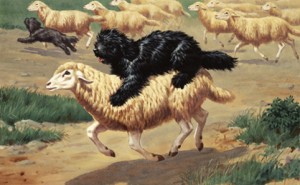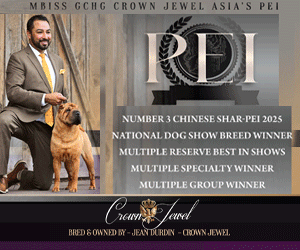Small Hungarian Sheepdogs – Puli, Pumi & Mudi
Click here to read the complete article
194 – November/December, 2014
text and illustrations by Ria Hörter
Russian Occupation
From the end of the ninth century, the early inhabitants of Hungary – the Magyars – kept their sheepdogs in the lowlands of the Carpathian Mountains. Only in the second half of the 19th century was the breeding of pedigree dogs begun, on the initiative of Count István Széchenyi (1791-1860), politician, theorist, writer and the founder of the Hungarian Academy of Science.
From 1849 until the First World War, Hungary was part of the Austro-Hungarian Empire. Activities such as breeding native Hungarian dogs were barely tolerated.
The Second World War and Russian occupation impeded contact with the free world. On the other hand, being isolated for so long may have protected Hungary’s native breeds from quick globalization.
Hungary has nine native dog breeds; five of them are sheepdogs.
PULI
“The Puli is a Hungarian herding breed of Asiatic origin. His original ancestors most probably came to the Carpathian Basin with the migrating ancient Magyars, who lived as nomads on stock-breeding.” (from the FCI standard)
The Puli’s name (plural Pulik or Pulis) means “small shepherd dog.” For centuries, it was used for herding and driving sheep. To protect the flock at night, shepherds used larger, mostly white-colored dogs – for example, the Kuvasz. When breeding, shepherds knew not to mix the two types because they were used for different work.
Smallest Hungarian Sheepdog
Shepherds maintained the pure bloodline and it is said that they furthered its improvement by keeping only the healthiest and most intelligent puppies. Through selective breeding, the Puli became an active, accurate, bright and lively little dog, about 17 inches (44 centimeters) at the withers, making him the smallest Hungarian sheepdog. Shepherds did not care about their dogs’ appearance, but selected only on working ability.
Dr. Emil Raitsits (1882-1934), a professor at the Faculty of Veterinary Sciences in Budapest, first divided the shepherd dogs into four categories: larger than 19.5 inches (50 centimeters), useful for guarding and police dogs; between 15.5 and 19.5 inches (40-50 centimeters), useful for herding cattle and pigs; between 13.5 and 15.5 inches (35-40 centimeters), useful for herding and driving sheep; and under 13.5 inches (35 centimeters), pet dogs.
Hungarian Expert
The first description of Hungarian sheepdogs was made by Fernce Pápai Páriz (1649-1716). The name “Puli” appeared for the first time in Hungarian literature in 1751. In the 1800s, there was no clear difference between the use of “Puli” and “Pumi.” It was only in 1902 that a distinction was made and a separate description of Pulis and Pumis was published. Controlled breeding began in the 1910s; unfortunately, many herds and Pulis were lost in the First World War (1914-18).
It’s hard to believe, but in 1915, in the middle of the Great War, the first Puli standard was written and internationally accepted.
Dr. Emil Raitsits (1882-1934), a leading Hungarian expert when it came to breeding animals, was editor of several dog magazines, and between 1916 and 1933 published a number of articles about dogs and breeding. Raitsits travelled around the country looking for good examples of sheepdogs he could use for a studbook. Supported by the government, he twice founded a club for breeders of Hungarian sheepdogs.
Budapest Zoo
The first pedigree was issued in 1924, and Dr. Raitsits became the first to publish a detailed study of the standard, which was accepted by the FCI in 1935, although with alterations.
At the Budapest Zoo, Raitsits’ assistant, Adolf Lendl, had his own facility for breeding Hungarian sheepdogs, under the affix Állartkerti (meaning “zoo”).
Because Dr. Raitsits promoted the recognition of all sizes and colors, and accepted dogs with an unknown background, he became a divisive element in the Hungarian dog world. After he committed suicide in 1934, his stud book disappeared. The 1955 revision of the standard determined the accepted sizes and colors.
Shaggy, Matting Coat
In the first descriptions of the Puli, the breed was described as “a type of medium-size sheep dog whose body is covered with a shaggy matting coat.” Such a coat is useful in the harsh temperatures on the pusztas, in summer as well as in winter. In the past, their coats were not as long as the standard now requires. Shorter hair was necessary to ensure free movement. However, today’s Pulis live in villages, towns and flats, and a long corded coat is popular. Other coat types are ribbon, wide ribbon, curly, tangled and matted. A silky, open or smooth coat is incorrect and should be excluded from breeding.
For years, the Puli’s coat color has been a subject of discussion. In the mid-19th century, breeders were of the opinion that only black Pulis, without any markings, were purebred. Today, solid black and reddish are popular, but apricot, various shades of gray, and white are also possible. Often the word “fako” is used, literally “faded.”
About 100 years ago there were Pulis with erect ears and a pointed muzzle, like the Pumi today. After 1920, when the Pumi became a separate breed, these characteristics in the Puli disappeared.
Burning Budapest
The First and Second World Wars were almost fatal for the Hungarian sheepdogs. After the First World War, Hungary lost large parts of the country to Russia, Romania, Czechoslovakia and Yugoslavia and, as a result, its large herds, and Pulis. At the same time, the Puli emerged as a companion dog. In 1924, 255 Pulis were registered in the Hungarian studbook.
Unfortunately, lack of food and veterinarians during the Second World War left the breed in dire straits and hundreds of Pulis were shot by Russian and German soldiers. The story goes that Ilona Orlay, one of Dr. Raitsits’ assistants, walked through burning Budapest pushing a chart containing valuable Hungarian sheepdog papers, from the office of the Hungarian Kennel Club to a place of safety.
Uprising
After the 1956 uprising against the Russians, it became possible to breed dogs on a slightly larger scale, and exporting dogs was sometimes possible.
In 1966, the FCI accepted a revised breed standard, including a separate version for white Pulis. White Pulis were officially recognized in 1973 and should not be interbred with any other color. During the last 50 years, Pulis have become more uniform in appearance. The most recent breed standard dates from 2013 and can be found at fci.be/nomenclature.aspx.
Pulis in North America
The Puli was accepted for AKC registration in 1936. The AKC standard is based on the 1936 Hungarian standard.
In 1978, a Puli from Mexico, Cinko Duda Csebi, was awarded Best in Show at the World Dog Show in Mexico City. Some Pulis have had great success in the States. Aust. BIS Grand, Can., Am. BIS & BISS Ch. Cordmaker Mississippi Mud was the No. 1 Puli and ranked in the Top 10 Herding Dogs in 1999, 2000, 2001 and 2002. ‘Amish’ is also the all-time top-winning Puli with more than 60 BISs and 500 group placements.
The Puli Club of America – puliclub.org – was formed in 1951.
PUMI
At the end of the 19th century, scientists divided “Puli type of dogs” into three categories: dogs with a coat of rounded or flat cords (Puli); dogs with a head like a terrier (Pumi); and dogs with erect ears (Mudi). The name “Pumi” was used for the first time in 1801, but long after that, “Puli” and “Pumi” were both used for the same dog, depending on where the animal was living. The name Pumi may have derived from Puli, but no one knows exactly where the name comes from. The first drawing of a Pumi dates from 1815.
The early history of the Pumi is the same as that of the Puli and Mudi. In the 17th and 18th centuries, the first separation took place as the result of cross-breeding the Pumi with German Pomeranians, French Briards, several varieties of terriers and, of course, the local Puli.
In the former Czechoslovakia there was a small sheepdog called Hajciarik; it resembled the Pumi and was never recognized as a separate breed.
Heritage
In the 18th century, large herds of Merino sheep were imported to Hungary, and with the herds came the small Pyrenean Mountain Dogs. It’s assumed that this breed also contributed to the development of the Pumi. The results of these crossings were dogs with a shorter, curlier coat than that of the Puli. The high-set, erect ears with the tips falling forward are the heritage of the terriers. From early days, this characteristic – pricked ears with dropped tips – was fixed in the breed. Looking at a Pumi, one can immediately see the terrier-shaped head.
Like the Puli, the Pumi was originally a herding dog, but was also useful as a guard dog. Another heritage of the terriers is their barking and feistiness – sometimes Pumis snapped at the sheeps’ legs like a heeler; most of them are excellent destroyers of small vermin. A Pumi needs a job, because when he can’t work he gets bored and will show this with bad behavior and endless barking.
Sheepdog Terrier
Dr. Emil Raitsits wrote the first breed standard (1921) and referred to the Pumi as a “sheepdog terrier.” Pumis became fashionable in the show ring and excelled as working dogs. According to Raitsits, it was important to preserve the typical terrier qualities of the Pumi. Before 1923, Pumis were shown as local varieties of the Puli, but at the Budapest Dog Show in 1927, the two breeds were already officially separated: 35 Pulis and 12 Pumis were entered.
It is remarkable that well-known European dog writers like Richard Strebel, Ludwig Beckmann and Count Van Bylandt, did not mention the small Hungarian sheepdogs in their books. It seems they were not aware of the existence and development of the Puli, Pumi and Mudi.
It takes time to separate one breed into two. It wasn’t until 1960 that Pulis and Pumis were fully differentiated by two different breed standards.
The Pumi has kept his old function as a cattle driver, but he is also used as a ratter and for hunting small game, and as a companion dog, show dog and agility dog.
The Pedigree Book of Hungarian Dogs records that 255 Pulis and 130 Pumis were registered in 1924.
Extremely Intelligent
There is a variety of Pumi types, as there was 80 years ago, and the heads in particular are different. During the 1950s, there were Pumis with a deep stop and sunken eyes, but also some with a sloping foreface and big eyes. Only the coat seems to have been consistent. Its nickname, “the clown,” comes from a small tuft on the ears that gives a charming, clownish appearance. The breed’s temperament is uncomplicated. They can be noisy and sometimes a bit sharp, but they are extremely intelligent and therefore suitable for agility.
The head is longer and more snipey than the Puli’s, and has less stop. A strong, defined stop is an eliminating fault. The Pumi’s coat is curly, but does not mat and is quite easy to groom. Pumis are sometimes born without a tail, or with a stumpy tail, but the standard requires a full tail. In countries where it was permitted, the tail was generally docked to two-thirds of its original length, but now a full tail is required. The smaller or larger ear tufts and typical ears make the clownish picture complete.
Most working sheepdogs in Hungary today are Pumis, but it’s also an assertive companion dog that can be a living burglar alarm.
The most recent breed standard, dating from 2000, can be found at fci.be/nomenclature.aspx.
The Pumi in America
The Hungarian Pumi Club of America Inc. – pumiclub.org – was formed in 2005 to “encourage and promote quality in the breeding of pure-bred Pumik (plural of Pumi), to do all possible to bring their natural qualities to perfection, to do all in its power to protect and advance the interests of the breed, and to encourage sportsman-like competition at dog shows, companion events, and performance events.”
The Pumi has been recorded in the AKC Foundation Stock Service® since 2001. In 2011, the Pumi was accepted by the AKC in the Miscellaneous Class.
It’s still a rare breed in the United States, with only one to three litters born annually. Breeders who are breeding non-recognized colors are not supported by the breed club.
MUDI (pronounced “Moody”)
Count István Széchenyi (1791-1860) was the founder of the Hungarian Academy of Science and The Pest County Greyhound Society, and one of the first promoters of Hungarian dog breeds. As we already know, Dr. Emil Raitsits, a professor at the Faculty of Veterinary Sciences in Budapest, traveled around the country looking for good examples of Hungarian sheepdogs, but seemed more interested in Pulis and Pumis than in the so-called “third type,” the Mudi (plural Mudik). Nevertheless, the Mudi is probably the oldest of the Hungarian sheepdogs, although the great unknown.
This third type of small sheepdog was and is known in almost the whole of Hungary. It is said that in ancient times, this little sheepdog could be found in the lowlands of Pannonia, now parts of Hungary, Austria and the former Yugoslavia. Some believe that he was the result of crossings between the Puli and the Pumi. Others believe that he derived from crossings between local sheepdogs, dogs from the Baltic States, and the Alsatian or German Spitz. It’s unverifiable, of course, but the last explanation is tempting, especially considering the shape of the head and the expression of the eyes.
Canis ovilis Fényesi
In the 1930s came the realization that Pulis with erect ears formed a definitively separate line in small Hungarian sheepdogs. Dr. Deszö Fényesi, director of the museum in Balassagyarmat, was one of the first breeders in Hungary to become involved in the separate breeding and exhibition of this small sheepdog, and was the one who named the breed Mudi. Why Mudi? Unfortunately, I have never found a good explanation. (The breed’s name in Latin is Canis ovilis Fényesi.)
Dog writer Emil Hauck did not pay much attention to the Mudi in his book Hirten- und Hütehunden (1965): “Mudi (Canis familiaris ovilis Fényesi, Anghi), for the first time presented by Prof. Fényesi in Budapest. Smaller than the Kuvasz, usually with erect ears, black.” That’s all. Erna Mohr, in her book about Hungarian sheepdogs (1956) did not mention the Mudi at all.
The FCI approved the breed standard in 1936, but there were few breeders then, and this is still the case today. As there were 80 years ago, there are many different Mudi types. They form a heterogenous company, resembling Spitz dogs in head and the Croatian sheepdog in body.
The Mudi is a working dog – a farmer’s dog – even more so than the Pumi or Puli. Today, most of them live on the farms in Hungary and the litters are often not registered. The Mudi is multi-functional – he drives the flock, guards the house and is extremely good at exterminating small vermin. He is an expert with difficult cattle and has also proven to be a good tracking dog. It is a blessing for this young breed that there is no separation between working lines and show lines. Since the 1970s, a small number have been exported, especially to Sweden and Finland.
Curly-Coated Small Spitz
The distinction between the Mudi and the Puli and Pumi is relatively small, but there are a few significant differences. First of all, the Mudi’s eyes are oval, dark and set obliquely, while the eyes of the Puli and Pumi are roundish. The Mudi’s ears are pricked, like those of a Spitz. The coat is not corded like the Puli’s, but short or half-long, and curly. Sometimes Mudis are born without a tail, or with a natural stump tail; this is not regarded as a fault. In general, the Mudi gives the impression of a curly-coated, small Spitz.
He is not as boisterous as the Pumi, which serves him well as a companion dog in the house. Still, the Mudi is not a dog for beginners. He needs a firm hand and a lot of exercise, especially if there is no real work to do. In Sweden and Finland, Mudis are used as tracking dogs, rescue dogs, for agility and to drive sheep.
In Hungary, one of the breed clubs was named after the man who founded the modern breed: the Fényes Mudi Klub.
Today there are several breed clubs outside Hungary, in the Czech Republic, Finland, Sweden, the U.S. and Canada, for example. The current breed standard, dating from 2004, can be found at fci.be/nomenclature.aspx.
The Mudi in America
The American Mudi Association, founded in 2003, is “the first National Breed Club for the Mudi in the USA” and “The only national breed club for the Mudi in America recognized and affiliated with MEOE (Hungarian Kennel Club).” More information about the Mudi can be found on their website: americanmudiassociation.org.
The Mudi Club of America – mudi.us/ – was founded in 2004 “to promote, protect and preserve the growing Mudi population. The American Kennel Club (AKC) has agreed to maintain Mudi records of registrations and pedigrees from domestic and foreign Mudi breeders in their Foundation Stock Service® (FSS) program.
We have tried to find the names of all photographers. Unfortunately, we did not always succeed. Please send a message to the author (riahorter.com) if you think you are the owner of copyright.
Ria Hörter is a dog writer from The Netherlands. She is the contributing editor of various Dutch dog magazines and works for the Dutch Kennel Club. She was nominated twice in the annual Dog Writers Association of America writing competition for her articles in Dogs in Canada. On April 12, 2014, she was awarded the Dutch Cynology Gold Emblem of Honour. The award was presented by the Dutch Kennel Club.
Short URL: http://caninechronicle.com/?p=64335
Comments are closed












